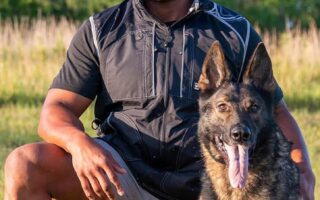Bird Dog Training: Harmonizing Nature and Skill
In the serene embrace of open fields and sun-dappled forests, the partnership between a hunter and their bird dog unfolds—a dance of instinct, training, and mutual respect. Bird dog training is more than just a skill; it’s a journey that transforms energetic pups into dedicated hunting companions and loyal friends. This intricate process weaves together techniques that refine natural instincts, enhance obedience, and build an unbreakable bond between dog and human. As the sun rises over the horizon and the first calls of birds break the morning silence, the world of bird dog training beckons, inviting both novices and seasoned hunters to explore the art of cultivating a perfect hunting partner. Whether you’re seeking to prepare your canine for a day in the field or to simply strengthen your connection, understanding the foundations and nuances of bird dog training will open doors to new adventures under the vast, expansive sky.
Table of Contents
- Understanding the Foundations of Bird Dog Training
- Effective Techniques for Instilling Reliable Retrieving Skills
- Building Stronger Bonds Through Positive Reinforcement
- Addressing Common Challenges in Bird Dog Training
- Q&A
- Closing Remarks
Understanding the Foundations of Bird Dog Training
At the core of effective bird dog training lies an understanding of the animal’s instincts and behaviors. Bird dogs are bred to retrieve game, which means harnessing their natural abilities is essential. Training should begin with fundamental concepts, emphasizing positive reinforcement to encourage desired behaviors while minimizing fear-based tactics. Establishing a strong bond with your dog through trust and respect facilitates a smoother training process. Techniques like socialization and exposure to various environments are crucial for developing a well-rounded canine companion. The earlier you start incorporating these elements into your training, the more responsive your bird dog will become.
Key components in bird dog training include consistent practice sessions and a structured approach to each lesson. Utilizing voice commands and hand signals helps to reinforce communication between handler and dog. It’s beneficial to focus on specific skills, such as retrieving, pointing, and tracking, ensuring that your dog develops proficiency in each area. Engaging in fieldwork exercises simulates real hunting scenarios, providing practical experience in a controlled environment. Remember, the ultimate goal is not only efficiency in retrieving but also the ability to listen and respond to commands effectively, cultivating a strong hunting partnership.
| Training Component | Importance |
|---|---|
| Positive Reinforcement | Encourages desired behaviors effectively |
| Socialization | Builds confidence and adaptability |
| Voice Commands | Enhances communication |
| Fieldwork Exercises | Prepares dog for real hunting scenarios |
Effective Techniques for Instilling Reliable Retrieving Skills
To cultivate reliable retrieving skills in your bird dog, it’s essential to utilize a variety of exercises and techniques that enhance their instincts and responsiveness. Begin with basic obedience drills to establish a strong foundation. By doing so, your dog will learn to focus on your commands, setting the stage for more complex retrieving tasks. Additionally, introduce structured games that mimic real-life hunting scenarios, such as:
- Delayed Fetch: Throw the dummy a short distance, then gradually increase the distance as your dog becomes more comfortable.
- Hand Signals: Teach your dog to respond to visual cues, which can be incredibly helpful in hunting situations.
- Controlled Retrieving: Utilize a leash during the early stages to maintain control as your dog learns to retrieve on command.
Moreover, incorporating varied terrains into your training sessions can help your dog adjust to different environments they may encounter during actual hunts. Use a mix of grass, sand, and woodlands to expose your dog to diverse scents and obstacles. Consider using a training table to clearly outline progress and techniques, ensuring you’re tracking improvements effectively:
| Technique | Description | Benefits |
|---|---|---|
| Obedience Drills | Builds command focus | Enhanced responsiveness |
| Delayed Fetch | Gradual distance increase | Boosted confidence |
| Hand Signals | Visual command training | Improves retrieval accuracy |
By consistently applying these techniques, you’ll be well on your way to developing a bird dog with reliable retrieving skills that are not only instinctive but precise.
Building Stronger Bonds Through Positive Reinforcement
Using positive reinforcement in bird dog training not only fosters an effective learning environment but also strengthens the relationship between handler and dog. Dogs, much like humans, thrive on encouragement and rewards. When they successfully complete a task or exhibit the desired behavior, rewarding them with treats, praise, or playtime cultivates a sense of accomplishment. This method encourages the dog to repeat the behavior, making training sessions more productive and enjoyable for both parties. Key aspects of positive reinforcement include:
- Consistency: Consistently rewarding the same behaviors sets clear expectations.
- Timing: Rewarding immediately after the behavior helps the dog make connections.
- Variety: Using various rewards keeps the training exciting and engaging.
As training progresses, handlers may introduce gradual challenges to test the dog’s skills and adaptability, reinforcing those successes along the way. Establishing a clear line of communication through commands and visual signals becomes crucial, helping the dog understand what is expected. To further illustrate the power of positive reinforcement, consider this simple table showcasing effective rewards:
| Reward Type | Description |
|---|---|
| Treats | Small, high-value snacks that motivate the dog. |
| Praise | Verbal affirmations that convey approval and joy. |
| Playtime | Engaging with toys or games as a form of reward. |
Addressing Common Challenges in Bird Dog Training
Training a bird dog can present a range of challenges that every owner should be prepared to tackle. One common hurdle is ensuring your dog maintains focus and enthusiasm during training sessions. It’s essential to keep the training fresh and engaging by varying the exercises and incorporating fun elements. Consider using positive reinforcement techniques to encourage desired behaviors, and always reward good performance. Break long sessions into shorter segments to keep your dog’s attention at its peak.
Another frequent issue is setting the right level of expectations for your dog’s progress. Since every dog learns at a different pace, it’s important to recognize and celebrate small victories. Develop a training timeline to track milestones and adjust your methods accordingly. Here are a few tips to help navigate this journey:
| Tip | Description |
| Regular Breaks | Include short breaks to prevent fatigue and maintain enthusiasm. |
| Consistent Commands | Use clear and consistent commands to avoid confusion. |
| Socialization | Expose your dog to different environments and situations for balanced training. |
| Patience | Be patient and give your dog time to absorb new skills. |
Q&A
Q&A: A Guide to Bird Dog Training
Q: What is bird dog training?
A: Bird dog training is a specialized form of training for hunting dogs, particularly breeds such as pointers, retrievers, and setters. The primary goal is to prepare these dogs to locate, flush, and retrieve birds efficiently during hunting outings. This training encompasses obedience, scent detection, and specific hunting commands to ensure the dog performs effectively and safely in the field.
Q: Why is bird dog training important?
A: Bird dog training is vital for several reasons. Firstly, it enhances the dog’s natural instincts, allowing them to perform tasks such as tracking and retrieving with skill and precision. Secondly, well-trained dogs promote safety in hunting scenarios, minimizing the risk of accidents. Lastly, this training fosters a strong bond between the dog and handler, built on trust and effective communication.
Q: At what age should I start training my bird dog?
A: Most experts recommend starting bird dog training between 6 to 8 weeks of age. At this stage, puppies are highly receptive to learning and socialization. Basic obedience commands and gentle exposure to bird scents can begin at this age. However, more specialized skills, such as retrieving and pointing, typically commence around 4 to 6 months, as the dog matures and builds confidence.
Q: What techniques are commonly used in bird dog training?
A: Various techniques are employed in bird dog training, including positive reinforcement, clicker training, and socialization exercises. Trainers often use live birds, scent trails, and whistle commands to simulate real hunting situations. Drills that strengthen obedience—like sit, stay, and heel—are also essential. The use of a training dummy or a “bumpers” can introduce retrieving concepts without the pressure of actual birds.
Q: How long does it take to train a bird dog?
A: The time frame for bird dog training can vary significantly based on factors like the dog’s breed, age, and individual temperament. Generally, basic training may take anywhere from a few weeks to several months. Advanced skills, particularly those needed for hunting, can take many months to years of consistent practice. Patience and regular training sessions are key to success in this journey.
Q: Can any breed be trained as a bird dog?
A: While certain breeds are more naturally inclined to excel in bird hunting—such as Labrador Retrievers, English Pointers, and German Shorthairs—some mixed breeds can also make excellent bird dogs. The crucial factor is the dog’s drive, temperament, and willingness to work. With the right training, dedication, and environment, many dogs can learn to perform hunting tasks.
Q: What are the common challenges faced during bird dog training?
A: Common challenges include distractions in the environment, high prey drive, and inconsistent commands. Dogs may become overly excited or anxious around live birds, making focus difficult. Additionally, handlers may struggle with maintaining patience or applying consistent training techniques. Recognizing and addressing these challenges promptly is essential for effective training.
Q: Are there any resources or tools that can assist in bird dog training?
A: Yes, various resources can enhance your training process. Books on bird dog training, online courses, and videos provide invaluable tips and techniques. Additionally, investing in quality training equipment, such as leashes, collars, dummies, and whistle commands, can greatly aid in your efforts. Consulting with professional trainers or joining training clubs can also offer support and camaraderie.
Q: What’s the most important thing to keep in mind while training a bird dog?
A: The most crucial aspect of bird dog training is to foster a positive learning environment. Patience, consistency, and encouragement will cultivate a motivated and eager learner. Celebrate small victories along the way, and remember that training should be a fun, rewarding experience for both you and your dog!
Closing Remarks
bird dog training is more than just a skill; it’s a journey that deepens the bond between handler and canine companion. Through patience, consistency, and understanding of a dog’s instincts, you can cultivate not only a proficient hunting partner but also a loyal friend. As you embark on this rewarding path, remember that every whistle, every retrieve, and every moment spent in the field enhances your connection. Whether you’re a seasoned hunter or a passionate novice, the art of bird dog training offers a unique blend of challenge and fulfillment, ensuring that each outing becomes a cherished memory in the great outdoors. So grab your training gear, head out into the wild, and watch as your efforts take flight, transforming your dog into a skilled partner ready to soar alongside you in the exhilarating world of bird hunting.



